The 2024 Toyota Prius wins MotorTrend's Car of the Year
The Toyota Prius — the gold-standard hybrid — has made a cultural impact far greater than its carbon footprint. When you hear "Prius," you might think of practical, eco-friendly transportation. Or perhaps you think it’s a virtue-signaling nerd-mobile. To many loyal owners, it's an appliance to get from A to B. To legions of ride-hail drivers, it's their office as they shuttle people and meals. For others, it's the annoying car taking up space in the fast lane — or the charming one covered with bumper stickers sitting next to you in traffic. And now, for the first time since 2004, the new Toyota Prius is our Car of the Year. It's remarkable how much we wrote about that game-changing 2004 Prius that still applies to its Car of the Year-winning successor two decades later:
"For sure, a certain amount of skepticism is understandable. Prior to this year's competition, it's unlikely that many MotorTrend editors had the 2004 Prius on their short lists. ... The all-new 2004 Prius, however, is an altogether more compelling car. Not only is it the first hybrid that an enthusiast can truly enjoy, it provides a tantalizing preview of a future where extreme fuel-efficiency, ultra-low emissions, and stirring performance will happily coexist in one package."
See more 2024 Car of the Year nominees: Finalists | Contenders
We can say the same about the new Prius. In a year with some seriously stiff all-electric competition in the form of the new Hyundai Ioniq 6 and revised Tesla Model 3 Highland, the hybrid and plug-in hybrid versions of Toyota's stalwart proved it's a more compelling car by combining traditional Prius brand values — efficiency, safety, and value — with newfound style and performance that are impossible to overlook.
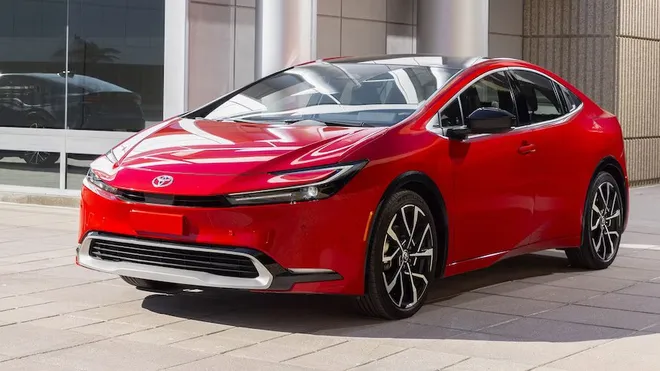
For the first time since that fateful second-generation car in 2004, Toyota designers and engineers had total freedom to rethink the Prius. Early drafts featuring subtle evolutions of the existing formula were thrown out in favor of a clean-sheet redesign that would serve as the halo hybrid of the company's lineup. It's now a car for those who might not traditionally consider a Prius. Longer, lower and wider than the one it replaces, the new model melds its unquestionably stylish new duds with a revised TNGA platform and the most serious rethink of its powertrains since 2008.
Gone are the 1.8-liter I-4 and afterthought of a plug-in-hybrid system, replaced by a new hybrid system anchored by a modern 2.0-liter four-cylinder, more powerful motors, and larger, more energy-dense batteries for up to 57 mpg for the Prius and up to 45 miles of all-electric range in the Prius Prime plug-in hybrid. It's also the first Prius available with all-wheel drive at launch. All starting right around $30,000, significantly undercutting America's average new car transaction price by more than $15,000. Our six criteria reign supreme when it comes to crowning a Car of the Year, and the new Prius delivers on each in such a way that its performance in one snowballs into the next, creating an absolute avalanche of excellence.
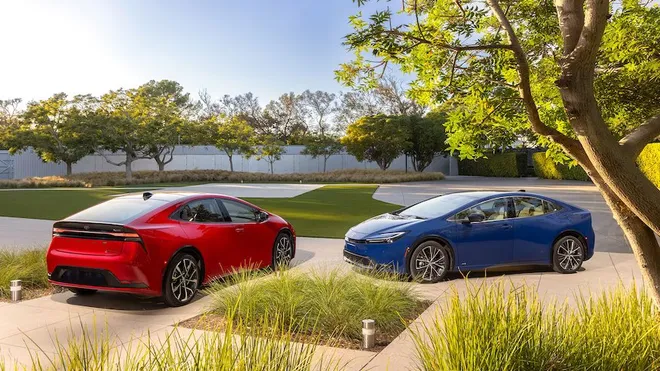
Toyota's advancement in design
Whereas the previous Prius seemed like it was designed by a committee that never bothered to step back and look at its creation, the fifth-generation Prius features a refreshingly cohesive — not to mention conventionally attractive — design. You can't help but do a double take when you see the car on the road.
Penned by Toyota's Japanese design studios, this Prius eschews the overt practicality and seemingly random angular lines of the outgoing Prius and Prius Prime in favor of a dramatic new profile with a stretched wheelbase; stylish, larger wheels; a slick windshield; sharp fastback roofline and tight kammback rear end. Up front the car wears Toyota's handsome Ferrari-ish new corporate nose, and in back it features a slim LED taillight spanning the car's width, complete with handsome new badging in three fonts. Especially cool is the Prius Prime's optional solar roof, which gives the car a sporty blacktop look while trickle-charging the battery pack. "Simply put, the new exterior design transforms the appearance from ugly commuter car to sporty coupe — one of the best low-cost cars," guest judge/legendary automotive engineer/designer Chris Theodore said.
The cabin isn't as dramatic as the exterior, but it's significantly improved without giving up on the practicality the nameplate is famous for. Like its sheetmetal, the new Prius' interior is refreshingly cohesive, eliminating the hodgepodge of piano-black and Apple-white plastics, obtuse low-resolution infotainment and instrument displays, and questionable materials found on prior generations.
Up front, all Priuses feature the cowl-mounted 7.0-inch LCD instrument cluster display from Toyota's bZ4X electric SUV, as well as a standard 8.0-inch Toyota Motor North America-engineered infotainment screen. A larger 12.3-inch screen is available on midgrade models and up. Although the interior color schemes of black or gray look like they were modeled after a New Yorker's wardrobe, silver (Prius) or red (Prius Prime) strips help break up the dash, with hard buttons for HVAC controls below.
2024 MotorTrend Awards:The Chevrolet Blazer EV Wins SUV of the Year
Beneath, for the first time in generations, is a real center console. "I appreciate the gearshift location," Detroit editor Alisa Priddle said. "It allows Toyota to place the cupholders horizontally, so you know whose cup is whose, leaving room for well-placed USB-Cs and a wireless charging slot for phones."
Functionally, the interior largely works for us, too. Despite shaving about two inches from its roofline, the Prius is well packaged. The comfortable front bucket seats offer plenty of headroom, while the rear seating is still adult-friendly, losing about an inch of headroom versus the earlier Prius but gaining about an inch each of leg- and shoulder room. The regular Prius' cargo area is shallower and a smidge smaller than before due to the hot new roofline, but the Prime gains cargo room versus the outgoing plug-in hybrid.
Despite the Prius faithful's relatively unfounded fear of losing practicality, the new car's largest design flaw is its use of the bZ4X's instrument cluster. There were near universal complaints among judges about the difficult-to-see screen. Any editor shorter or taller than average height lost up to three-quarters of the information — such as speed, range, and safety system status — displayed on the instrument cluster. Shorter drivers couldn't see the bottom of the display; taller ones struggled to see the top. "I still dig this futuristic starfighter helm of a steering wheel and instrument cluster," features editor Scott Evans said, "though I wish Toyota would bump the instrument cluster screen just a little bit higher. I'm average height, and I feel like I must have the steering wheel almost in my lap to comfortably see over it and read the whole screen. You get used to it, but it's caused plenty of people issues." Add to Evans' suggestion an increase in the display's font size; even those with 20/20 vision struggled to shift their focus quickly from the road to the display.
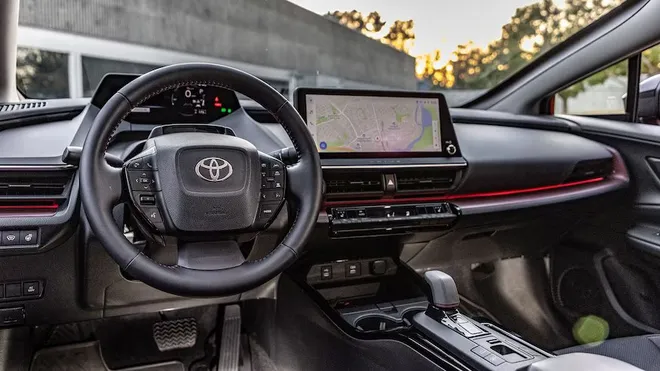
Safety
The above concerns aside, our 2024 Car of the Year aces the traditional safety tests. The Insurance Institute for Highway Safety gives the Prius and Prius Prime its coveted Top Safety Pick+ rating for both its crashworthiness and its crash-avoidance technology. The National Highway Traffic Safety Administration has yet to test a fifth-generation Prius, but every model that's preceded it scored the highest possible 5-Star overall rating. With eight standard airbags and simple yet robust active driving aids, we'll be surprised if this one doesn't match that score.
Value
The anticipated safety bona fides are especially remarkable considering how reasonably priced the 2024 Prius is. The base Prius LE starts at just $28,745 and includes necessities like wireless Apple CarPlay and Android Auto, blind-spot monitoring, and rear cross-traffic alert. The Prius XLE, at $32,190, adds style in the form of 19-inch wheels, safety with parking assist and automatic emergency braking, and convenience with heated front buckets. It also opens the options list to features like a sunroof or that larger infotainment display. The Prius Limited, meanwhile, adds all the bells and whistles — save for optional heated rear seats and digital rearview mirror — for $35,760. Those who desire AWD need to spend just $1,400 more on any trim to add a rear-mounted motor for more traction.
The Prius plug-in hybrid is well priced, too. Mirroring the options walk of the Prius, the Prius Prime SE starts at just $33,770, the XSE at $37,020, and the XSE Premium at $40,465.
Engineering excellence
Built off Toyota's second-gen TNGA-C platform, the Prius' chassis is more structurally rigid than before, with a lower center of gravity, too, thanks to its slightly lower ride height and battery pack located under the rear seat.
That battery pack — 0.91 kWh in the Prius and 13.6 kWh in the Prime — sees Toyota finally put NiMh chemistry out to pasture in favor of lighter and more energy-dense lithium-ion. The batteries support a modern new 2.0-liter I-4 that produces 150 hp, a significant boost from the 95-hp unit found in earlier Priuses. In front-drive hybrids it gets paired with a permanent-magnet motor and generator setup good for 111 hp , while all-wheel-drive versions also add a rear-mounted 40-hp unit to the mix. Total peak system output is a healthy 194 hp for front-drivers and 196 hp for the Prius AWD.
The Prius Prime gets an even more powerful 161-hp front motor arrangment, bringing system output up to a peak of 220 hp. Aside from the optional solar roof, the Prius Prime charges via an onboard 3.5-kW charger. Although this is fairly common for PHEVs in this price bracket, we're disappointed the optional 6.6-kW charger on the RAV4 Prime isn't standard equipment. That would halve the Prime's roughly four-hour charge time on a Level 2 charger, making it even easier for owners to keep the battery brimmed while out and about. Should you choose to forgo the expense of installing a Level 2 charger at home, the Prime's battery will charge from empty to full in about 12 hours on a normal household outlet via the included Level 1 charger.
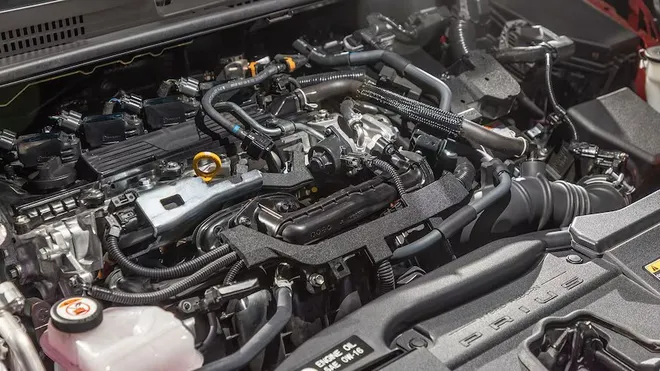
Both Priuses continue to share a carryover planetary e-CVT automatic, but Toyota redid the braking system, adding an active hydraulic booster that both improves brake pedal feel and smooths the handoff between regenerative and friction braking.
The result? "This is genuinely a fun car to drive," deputy editor Alexander Stoklosa said. "Not for a Prius — for a compact car generally."
Executive editor Mac Morrison agreed: "What's this? A chassis that isn't deathly allergic to spirited driving? I was able to keep up with Evans in a Model 3 on twisty Cameron Road with zero trouble. And I had a smile while doing so. Never before have I experienced this in a Prius."
With responsive, accurate steering and a composed chassis that takes to potholes as well as it does to corners, the Prius is a lovely car to eat up the miles in, even if it's still a bit noisy inside. We suspect adding some sound deadening to the tinny doors would go a long way toward improving the latter.
Power delivery feels much like it did in the old version — meaning a clear mashup of multiple power sources punctuated by the occasional racing of the engine — but the new powertrain's added torque really smooths things out. When not driving and beating on it like a taxi driver, the Prius is punchy off the line and responsive to throttle input, turning what once were white-knuckle passing maneuvers or merges in the old Prius into stress-free affairs. The Prius Prime, meanwhile, "is better in almost every way than the regular Prius," associate editor Billy Rehbock said. "It's quieter both in terms of road noise and drivetrain volume, but it also has better acceleration."
2024 Toyota Tacoma:Our review of Toyota's benchmark pickup truck
The powertrain calibration in the Prius Prime is remarkably well done. With a charged battery, the Prime fires up in EV mode and, unlike many PHEVs, stays in EV mode unless you push the throttle past the kickdown point on the floor. The motor is rich with torque; it's powerful and smooth, making the Prius Prime feel more like a full EV than a plug-in. We even did a full 0-60 run under electricity, hitting the mark in a respectable 10.5 seconds. (Of course, the Prius Prime is quickest with both powerplants going, hitting 60 mph in 6.4 seconds — just a second behind the GR Corolla hot hatch.) "I love this car," buyer's guide director Zach Gale said. "Just the right amount of power to be useful but not intimidating."
Should you want to save some charge during freeway driving, we found the Auto setting does a great job at milking the EV range and boosting efficiency. Once the battery finally runs dry, the Prius Prime converts into a more powerful, quieter Prius, operating under electricity for longer than its hybrid sibling and supplementing that when needed by quickly firing up the engine. "The Prime really is the one to get," Evans said. "It feels noticeably quicker, and the all-electric driving range is sufficient for most people's commutes." Theodore concurred: "I strongly prefer the Prime. Its hybrid capability provides improved performance on demand and eliminates range anxiety while offering up a total equivalent mpg-e rating that's comparable to pure EVs."
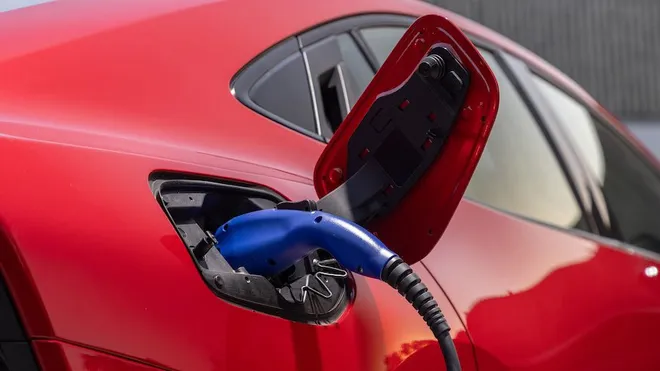
Efficiency
We're used to give and take when it comes to cars. A manufacturer gives us more power and naturally takes some efficiency away. It's a tried-and-true paradigm — one the 2024 Prius somehow shatters. Base Priuses net an EPA-rated 57/56/57 mpg city/highway/combined, improving on the 58/53/56 mpg rating of the most efficient previous-gen Prius. Midgrade and up Priuses net 52/52/52 mpg.
The most efficient Prius Prime SE, meanwhile, is EPA-rated at 127 mpg-e combined, a hair under the previous-gen Prime's 133 mpg-e score, but the new model also offers 20 more miles of EV range (45 total). Mid- and upper-tier Primes net a still impressive 114 mpg-e and 40 miles of range. Regardless of spec, the Prius Prime is the most efficient plug-in hybrid on the road today.
Performance of intended function
And here's where the avalanche climaxes. The Prius has historically been the default choice for people willing to sacrifice style and performance in favor of practicality, efficiency and affordability. For those folks, the new 2024 Prius is, as Rehbock put it, "beyond adequate; it's evolved from being a boring car you settle on when you need something practical to become a charming and stylish hatchback with tons of curb appeal."
The trick, then, is capturing those who've never considered a Prius before or who are interested in electrification but are scared off by the vast unknown that is the modern public charging network. Folks like, in the former case, an introspective Morrison. "The most impressive thing about this new Prius is that it's converted me from being a Prius hater to being able to picture myself owning one," he said. "This is the first Prius I've driven that I didn't want to forget about the moment I climbed out of it. This new car looks so sharp, so cool, so interesting, I'm happy about driving it before I ever roll forward a single foot."
And guess what? When you do roll past that foot, you find the most fun-to-drive Prius ever. Some might dismiss that as unnecessary, but in a world where the Tesla Model Y is among the bestselling vehicles, the Prius is no longer the default option when it comes to affordable, efficient transportation. To continue its success, Toyota needed to broaden its appeal well beyond its traditional base. The company did just that with the 2024 Prius. It's more attractive, more efficient, better to drive, and just as affordable as before. It's unquestionably our 2024 Car of the Year.
2023 Toyota Prius Limited; Prime XSE specifications
DRIVETRAIN LAYOUT Front-engine/motor, FWD
ENGINE TYPE Port- and direct-injected Atkinson-cycle DOHC 16-valve I-4, alum block/head, plus permanent-magnet electric motors
DISPLACEMENT 1,987 cc/121.3 cu in
COMPRESSION RATIO 14.0:1
POWER (SAE NET) 150 hp @ 6,000 rpm (gas), 111 hp (elec) 161 hp (elec); 194 hp (comb) 220 hp (comb)
TORQUE (SAE NET) 139 lb-ft @ 4,400 rpm (gas), 152 lb-ft (elec); NA lb-ft (elec), NA lb-ft (comb)
REDLINE Not indicated
WEIGHT TO POWER 21.4; 16.2 lb/hp
TRANSMISSION Cont variable auto
AXLE/FINAL-DRIVE RATIO 3.39:1; 3.61:1/NA
SUSPENSION, FRONT; REAR Struts, coil springs, anti-roll bar; multilink, coil springs, anti-roll bar
STEERING RATIO 13.6:1
TURNS LOCK-TO-LOCK 2.7
BRAKES, F; R 11.1-in 12.0-in vented disc; 11.0-in disc
WHEELS 6.5 x 19-in cast aluminum
TIRES 195/50R19 88H Toyo Extensa AS II (M+S)
DIMENSIONS
WHEELBASE 108.3 in
TRACK, F/R 61.7/61.8 in
LENGTH x WIDTH x HEIGHT 181.1 x 70.2 x 56.3 in
TURNING CIRCLE 35.4 ft
CURB WEIGHT (DIST F/R) 3,211 lb (60/40%); 3,567 lb (56/44%)
SEATING CAPACITY 5
HEADROOM, F/R 38.0/36.4 in
LEGROOM, F/R 43.2/34.8 in
SHOULDER ROOM, F/R 55.3/52.8 in
CARGO VOLUME 20.3 cu ft (26.7 cu ft seats folded)
ACCELERATION TO MPH
0-30 2.6; 2.6 sec
0-40 3.8; 3.6
0-50 5.5; 4.9
0-60 7.5, 6.4
0-70 10.0; 8.3
0-80 13.1; 10.6
0-90 — ; 13.3
PASSING, 45-65 MPH 4.0; 3.1
QUARTER MILE 15.8 sec @ 87.5 mph; 15.0 sec @ 95.4 mph
BRAKING, 60-0 MPH 132; 122 ft
LATERAL ACCELERATION 0.82 g; 0.82 g (avg)
MT FIGURE EIGHT 27.5 sec @ 0.61 g (avg); 27.2 sec @ 0.63 g (avg)
TOP-GEAR REVS @ 60 MPH NA
CONSUMER INFO
BASE PRICE $35,560; $36,695
PRICE AS TESTED $37,494; $43,648
AIRBAGS 8: Dual front, f/r side, f/r curtain
BASIC WARRANTY 3 yrs/36,000 miles
POWERTRAIN WARRANTY 5 yrs/60,000 miles (10 yrs/150,000 miles battery)
ROADSIDE ASSISTANCE 2 yrs/25,000 miles
FUEL CAPACITY 11.3 gal + 0.9 kWh; 10.6 gal + 13.6 kWh
EPA CITY/HWY/COMB ECON 52/52/52 mpg; 50/47/48 mpg (gas), 125/103/114 mpg-e (gas + elec)*
EPA RANGE, COMB 588 miles; 39 (elec), 550 (gas + elec)* miles
RECOMMENDED FUEL Unleaded regular, 120-/240-volt electricity
ON SALE Now
*EPA blended-PHEV (charge-depleting) mode testing, with vehicles set to their default drive and brake-regeneration modes
Disclaimer: The copyright of this article belongs to the original author. Reposting this article is solely for the purpose of information dissemination and does not constitute any investment advice. If there is any infringement, please contact us immediately. We will make corrections or deletions as necessary. Thank you.







